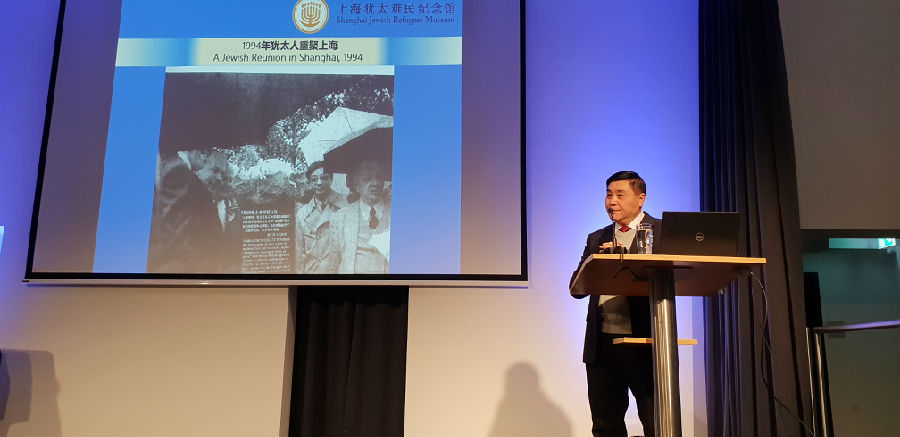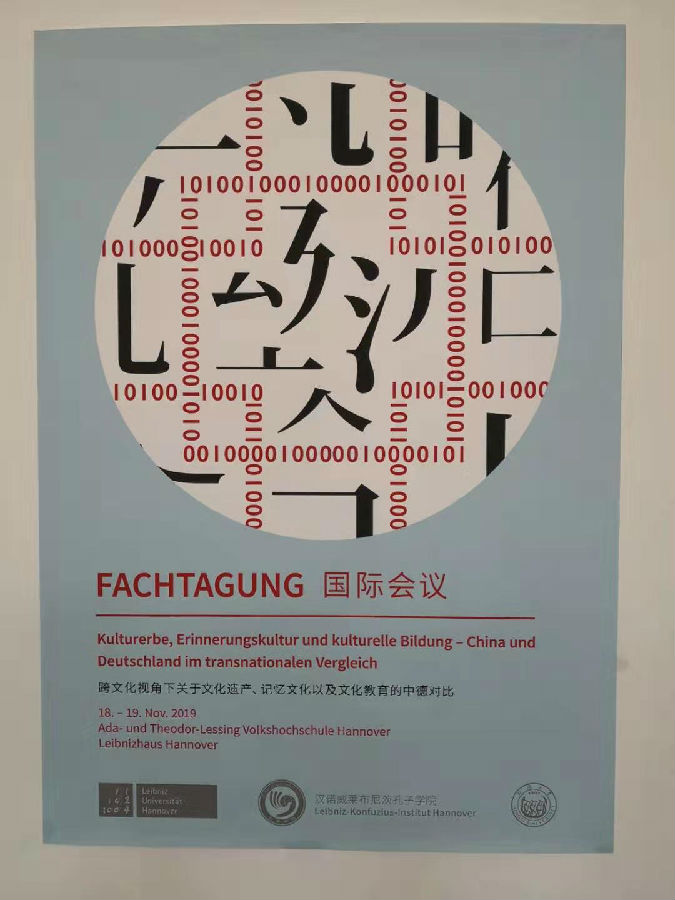Latest
Latest
Sino German International Conference was held in Hanover Germany
Time:2019/11/21 13:02:47

On November 18 and 19, the SinoGerman International Conference on Cultural Heritage, Cultural memory and Cultural Education from a CrossCultural Perspective, jointly sponsored by the Confucius Institute leibniz in Hanover and Tongji University, was held in Hanover Germany.
Mr. Chen jian, director of the Shanghai Jewish Refugees Museum, attended the conference and delivered a speech entitled "Preserving the Memory of the City, Safeguarding Peace". After the speech, he had a warm exchange with the audience on the implementation of the international cooperative research, communication and education project on the historical event of Jewish asylum in Shanghai during World War II.

Preserving the Memory of the City, Safeguarding Peace
I. Discovering history
The Tilanqiao Historical and Cultural Legacy Area is a well-preserved zone of former Jewish settlements. It is the only heritage site that carried the experience of Jews in China during World War II.
In 1994, a Jewish Reunion (the Rickshaw Reunion) was organized in Shanghai by Shanghai Municipal Government and Hongkou District Government. It was the first time that the former Jewish refugees had returned to Shanghai after China opened up to the outside world. More than 60 Jews, including former Jewish refugees, Jewish community leaders, experts and scholars from all over the world, came to Shanghai in search of the memory of Jews in Shanghai 50 years ago. They visited places where the former refugees had lived, and then gathered in Wayside Park to unveil a Monument of Jewish Refugees. It was raining that day, and rain and tears streamed down the face of the participants.
It is a pity, however, that not many people in Shanghai besides the residents of this area know about this historyalthough it is not too far away. The reunion had led to the discovery of this important and special history.
In 2008, an area of 2.94 square kilometers where the Jews had lived as refugees in the 1930s and 1940s was put under protection as a heritage zone by the government. In October 2007, the renovated Ohel Moishe Synagogue, where the refugees had often gathered and celebrated religious occasions, was opened to the public as Shanghai Jewish Refugees Museum.
II. Collecting memories
Historical records and objects are the best medium to help us remember the history. However, in 2007, the Museum did not have a single historical object that bears the memory. The exhibition in the Museum was designed merely according to the descriptions by Prof. Pan Guang of Shanghai Academy of Social Sciences in his book Jews in Shanghai.In order to understand this history more deeply and disseminate the memory, we've been trying to collect historical objects and records through various channels.
At first, most of our visitors were foreigners, mainlyformer Jewish refugees, descendants, relatives and friends of former refugees, and scholars who studied this history. That offered us great opportunities to collect historical clues, because they were the witnesses or people who had close contacts with the witnesses.
Next, we trained our staff so that they were able to identify visitors who might possess objects and records we want. Afterwards, we've managed to obtain a considerable amount of such objects and records through effective communication.Meanwhile, we also managed to collect historical objects and facts from the residents in this neighborhood. Jewish refugees had lived in this area and gave some belongings such as furniture to the residents there.
Since 2011, we have brought our exhibition of Jewish Refugees in Shanghai to one or two foreign countries every year, which became another channel to collect exhibits. We have visited Germany, Israel, the United States and Australia, which had direct connections with this history. In these countries, we've found witnesses or their families or relatives. Sometimes, we went straight into the local Jewish community to visit former Jewish refugees, who have given us a lot of precious historical legacies.
It is a very difficult process, but it is full of exciting and sensational moments. In 2008, a former Jewish refugee named Ruth visited our Museum, bringing with her a passport and a sandalwood fan. She said that she had used the fan in Shanghai, and it was light and smelled good. This is the first time I had seen any real object belonging toformer Jewish refugees. I was thrilled. I asked the old lady to give them to the Museum. She told us that they had remained with her for decades, and many Holocaust memorials had also come to ask her for her belongings. She had already donated so many things, and she regarded the rest as an inseparable part of her life. She would not give them away until she died. I said I understood her and asked her to give us something when she felt she would love to.
One day in 2013, an American old man suddenly came to Shanghai. He told me that Ruth had passed away. Ruth asked him to give all the five passports she had used in her life to our museum. The old man also told me that Ruth was sorry because the sandalwood fan was broken and she could not give it to us.Holding the passports, I felt sad and grateful. Ruth had kept her promise. She was honorable.
I am also grateful to Joseph of Hamburg, Germany. He gave us a toy rickshaw, which is the first non-paper legacy we've received.
In 2014, we built a memorial wall in our museum, on which we inscribed the names of 13,721 former refugees in Shanghai. The people who come to look up names on the wall are usually the ones we are looking for, because they are either former refugees or relatives. Up to now, our museum has collected more than 800 historical objects, which piece up a complete story of the Jewish refugees in Shanghai.
III. Sharing the memory
Whenever we discovered an important historical legacy, we’d usually share it, as well as the touching story it tells, with the public through the press. As more and more stories are shared, our museum has attracted more and more attention.Visit to our museum has increased 10 times since we're first open.
With the hope of giving our exhibits a better "home" and giving our visitors a more comfortable experience, we're building a new hall with a floor space of 4,000 square meters with the support of Shanghai Municipal Government and Hongkou District Government. The new hall will be open to the public by the end of next August. It is four times as large as the current building.
We've been holding international exhibitions since 2011, and we began with Hamburg, Berlin and Hannover. Up to now, we have reached 15 cities in 8 countries. We've also held exhibitions in some universities in Beijing, open to Chinese and international students and teachers.
IV. Remembering the history
This memory is important to former Jewish refugees, to all Jews, and even to all people in the world who aspire to peace. During our exhibition in New York, New York Times published an article about the exhibition and the history of Jewish refugees in Shanghai, saying that the exhibition truthfully reflected the special history during World War II. The article found a strong echo in the United States. This writer is a "Shanghai Baby", a Jew born in 1947 in Shanghai. His article was full of nostalgia for Shanghai. There were 500 Jewish babies born in Shanghai, like the writer.The stories had aroused their buried feelings about Shanghai, and played a role in preserving the shared memory of Chinese and Jews.
In the 1930s and 1940s, Shanghai was threatened and occupied by the Japanese, and the people had a hard time. But when the European Jews were suffering from Nazi persecution and needed help, the people of Shanghai opened their arms to them.
At present, there are still many conflicts in the world. I believe we can address conflicts so long as we adopt a friendly and inclusive attitude towards each other. Chinese President Xi Jinping proposed that we should build a community with a shared future. So, let's remember history, learn from history, and jointly build a peaceful and beautiful home for mankind.



